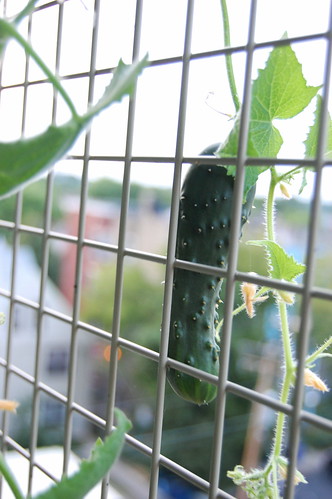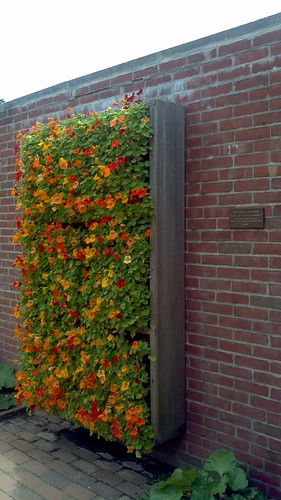By Nancy.
Vertical gardens are ideal for those with limited space such as apartment or condominium residents. Homes with limited ground space such as duplexes, beach houses and mobile homes also adapt well to vertical gardening. With a little help from vertical supports, vegetable plants no longer have to lay unattended, languishing in the mud. Nor do they need to unnecessarily rot on the vine because of over-saturation from standing water. A vertical garden allows plants to stand tall and do what they do best—produce fresh-off-the-vine goodness.
The Best Vegetables for Vertical Gardens

Photo of a Cucumber by random letters via Flickr
Vertical gardens enable vegetables such as pole beans to twine their stems to the support while sweet peas use tendrils to wind and climb their way up the support. Moving upward keeps plants off the ground and away from insects.
Another advantage of vertical gardening allows multiple plantings in a localized area for plants such as strawberries and tomatoes. Verticals also provide control over vegetables with exceptionally long vines like the summer squash.
The region you live in and its climate will determine the types of vegetables suitable for your garden, but in general, vegetables that fare well with vertical gardening include:
- Radishes
- Cherry Tomatoes
- Lettuce
- Cucumbers
- Strawberries
- Gourds
- Cooking greens such as collards, spinach and kale
- Sweet peas
- Winter squash
- Pole beans
- Melons
- Pumpkins
Preparing the Garden Area

Photo by margoc via Flickr
The first step is choosing an area receiving optimal sunlight. Once selected, purchase a soil testing kit to determine the soil type. Depending on the results, the soil may need enhancing with fertilizers and nutrients.
For in-ground gardens, prep the soil before constructing vertical bases or adding plants. For small areas, a hoe, shovel, and spade can easily dig and turn the soil. For large gardens, you may want to rent a tractor or backhoe capable of digging, lifting and loading to efficiently prep the area.
If you’re going to be planting in containers, choose pots with adequate drainage such as ceramic pots, crates, vintage wash tubs, barrels or any durable container. If the container does not have drainage, drill several small holes to filter water through. Fill containers with compost-rich soil and mix in perlite or peat moss to aid with drainage. Good drainage eliminates root rot due to standing water.
Constructing Verticals

Photo by Miriella via Flickr
The key to a successful vertical garden is providing secure and sturdy support for the vegetables. Bean vines are lightweight and can be secured with sturdy string. Heavier vegetables such as gourds, pumpkins and melons are secured using twine, cloth strips or slings made out of breathable fabric.
Vertical garden structures have multiple options. Exterior walls of a patio, balcony, building, garage or storage shed provides excellent support. Other options include tripods, trellises, fences, arches, wire cages and arbors.
Be creative. Use items like an old ladder, a rose trellis, sheets of lattice or a three-tiered metal hanging basket from the kitchen. Additionally, bamboo poles and other plants in the garden such as corn stalks and sunflowers provide sturdy support.
Each support must be securely anchored, whether it’s in the ground or a container. If using containers, each must be deep enough to accommodate the plant and staking the vertical support.
About the Author: Nancy is a stay-at-home mom who blogs about a variety of topics from her basement office deep in the heart of Dixie.









2 pings
[…] More at Prepper-Resources: A Get Started Guide To Vertical Gardening […]
[…] Vertical Gardening Makes for a good idea worth giving more space to a small garden, your ideas….. https://www.prepper-resources.com/a-g…cal-gardening/ […]